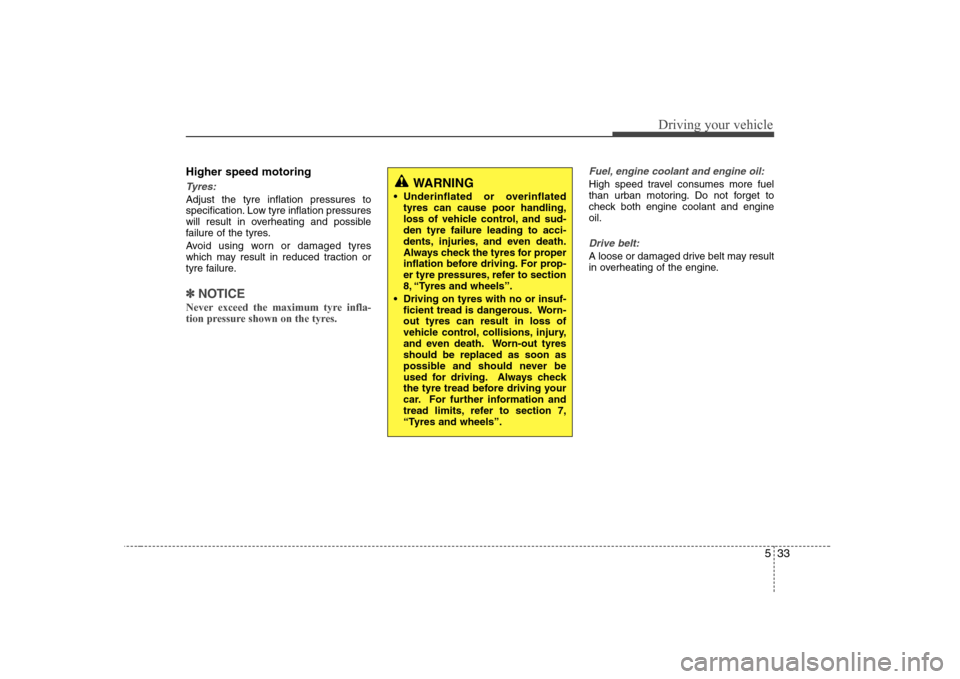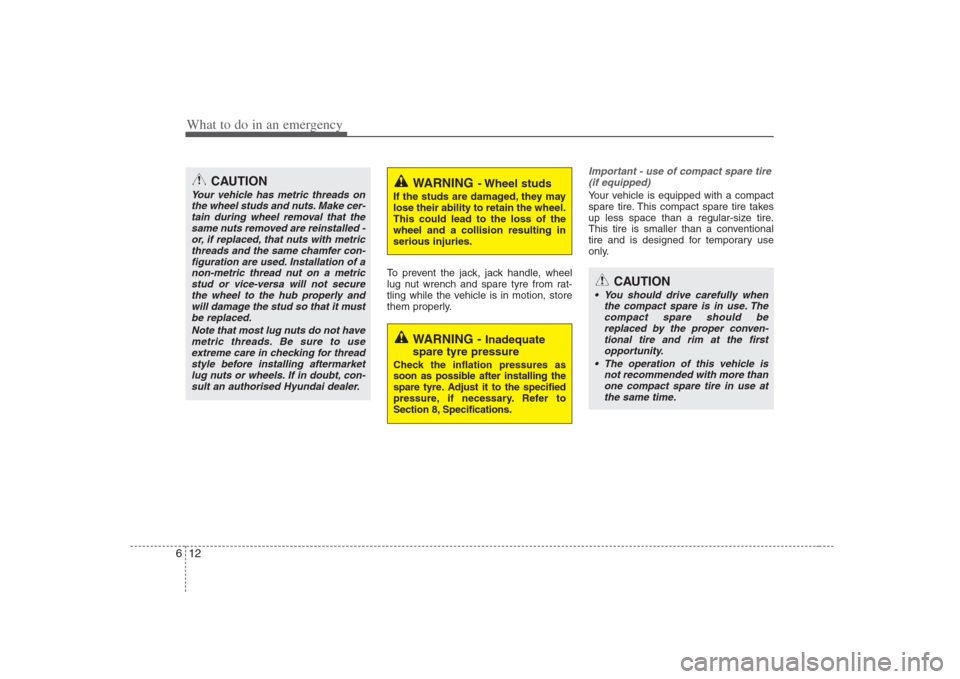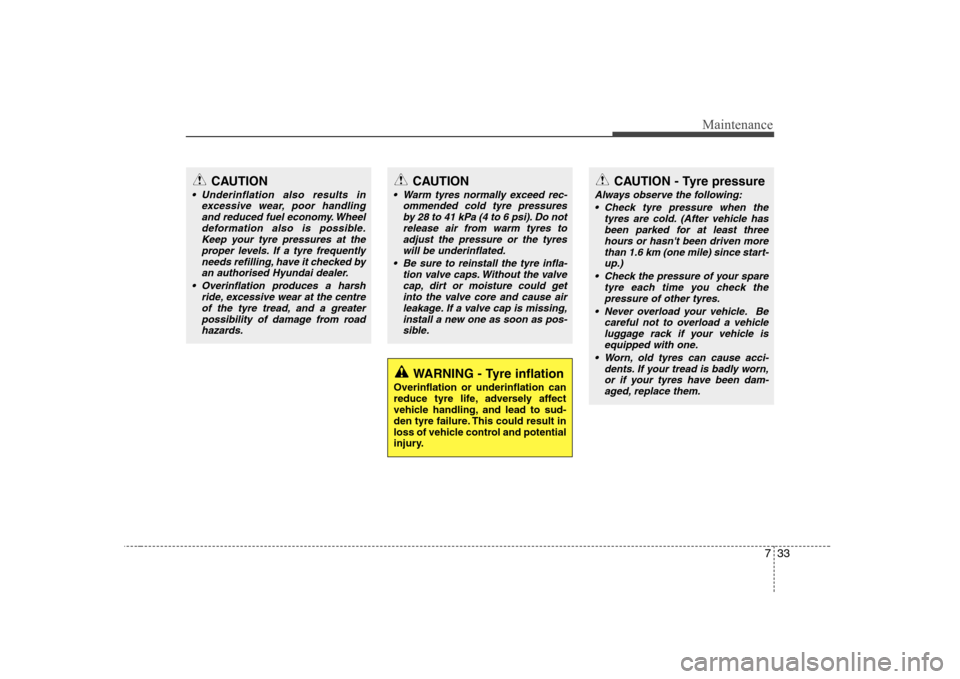2009 Hyundai Elantra inflation pressure
[x] Cancel search: inflation pressurePage 37 of 308

Safety system of your vehicle
28
3
Upon deployment, tear seams molded
directly into the pad covers will separate
under pressure from the expansion of the
air bags. Further opening of the covers
then allows full inflation of the air bags. A fully inflated air bag, in combination
with a properly worn seat belt, slows the
driver's or the passenger's forward
motion, reducing the risk of head and
chest injury. After complete inflation, the air bag
immediately starts deflating, enabling the
driver to maintain forward visibility and
the ability to steer or operate other con-
trols.
B240B02L-RB240B03L-R
Driver’s front air bag (2)Driver’s front air bag (3)
WARNING
Do not install or place any acces- sories (drink holder, cassette
holder, sticker, etc.) on the front
passenger's panel above the
glove box in a vehicle with a pas-
senger's air bag. Such objects
may become dangerous projec-
tiles and cause injury if the pas-
senger's air bag inflates.
When installing a container of liq- uid air freshener inside the vehi-
cle, do not place it near the
instrument cluster nor on the
instrument panel surface.
It may become dangerous pro-
jectiles and cause injury if the
passenger's air bag inflates.
B240B05L-R
Passenger’s front air bag
Page 191 of 308

529
Driving your vehicle
Your vehicle's fuel economy depends
mainly on your style of driving, where you
drive and when you drive.
Each of these factors affects how many
kilometers you can get from a litre of fuel.
To operate your vehicle as economically
as possible, use the following driving
suggestions to help save money in bothfuel and repairs:
Drive smoothly. Accelerate at a moder-ate rate. Don't make “kangaroo” starts or full-throttle shifts and maintain a
steady cruising speed. Don't race
between stoplights. Try to adjust your
speed to that of the other traffic so you
don't have to change speeds unneces-
sarily. Avoid heavy traffic whenever
possible. Always maintain a safe dis-
tance from other vehicles so you can
avoid unnecessary braking. This also
reduces brake wear.
Drive at a moderate speed. The faster you drive, the more fuel your car uses.
Driving at a moderate speed, especial-
ly on the highway, is one of the most
effective ways to reduce fuel consump-tion. Don't "ride" the brake or clutch pedal.
This can increase fuel consumption
and also increase wear on these com-
ponents. In addition, driving with your
foot resting on the brake pedal may
cause the brakes to overheat, which
reduces their effectiveness and may
lead to more serious consequences.
Take care of your tyres. Keep them inflated to the recommended pressure.
Incorrect inflation, either too much or
too little, results in unnecessary tyre
wear. Check the tyre pressures at leastonce a month.
Be sure that the wheels are aligned correctly. Improper alignment can
result from hitting curbs or driving too
fast over irregular surfaces. Poor align-
ment causes faster tyre wear and may
also result in other problems as well as
greater fuel consumption.
Keep your car in good condition. For better fuel economy and reduced
maintenance costs, maintain your carin accordance with the maintenance
schedule in Section 7. If you drive your
car in severe conditions, more frequentmaintenance is required (see Section
7 for details). Keep your car clean. For maximum
service, your vehicle should be kept
clean and free of corrosive materials. It
is especially important that mud, dirt,
ice, etc. not be allowed to accumulate
on the underside of the car. This extra
weight can result in increased fuel con-
sumption and also contribute to corro-sion.
Travel lightly. Don't carry unnecessary weight in your car. Weight reduces fuel
economy.
Don't let the engine idle longer than necessary. If you are waiting (and not
in traffic), turn off your engine and
restart only when you're ready to go.
Remember, your vehicle does not require extended warm-up. After the
engine has started, allow the engine to
run for 10 to 20 seconds prior to plac-
ing the vehicle in gear. In very cold
weather, however, give your engine a
slightly longer warm-up period.
Don't “labour” or “over-rev” the engine. Labouring is driving too slowly in toohigh a gear resulting in the engine
bucking. If this happens, shift to a lower
gear. Over-revving is racing the engine
beyond its safe limit. This can be avoid-
ed by shifting at the recommended
speeds.
ECONOMICAL OPERATION
Page 195 of 308

533
Driving your vehicle
Higher speed motoring
Tyres:
Adjust the tyre inflation pressures to
specification. Low tyre inflation pressures
will result in overheating and possible
failure of the tyres.
Avoid using worn or damaged tyres
which may result in reduced traction or
tyre failure.
✽✽NOTICE
Never exceed the maximum tyre infla-
tion pressure shown on the tyres.
Fuel, engine coolant and engine oil:
High speed travel consumes more fuel
than urban motoring. Do not forget to
check both engine coolant and engineoil.
Drive belt:
A loose or damaged drive belt may result
in overheating of the engine.
WARNING
Underinflated or overinflated tyres can cause poor handling,
loss of vehicle control, and sud-den tyre failure leading to acci-
dents, injuries, and even death.
Always check the tyres for proper
inflation before driving. For prop-
er tyre pressures, refer to section
8, “Tyres and wheels”.
Driving on tyres with no or insuf- ficient tread is dangerous. Worn-out tyres can result in loss of
vehicle control, collisions, injury,
and even death. Worn-out tyresshould be replaced as soon as
possible and should never be
used for driving. Always check
the tyre tread before driving your
car. For further information and
tread limits, refer to section 7,
“Tyres and wheels”.
Page 220 of 308

What to do in an emergency
12
6
To prevent the jack, jack handle, wheel
lug nut wrench and spare tyre from rat-
tling while the vehicle is in motion, store
them properly.
Important - use of compact spare tire
(if equipped)
Your vehicle is equipped with a compact
spare tire. This compact spare tire takes
up less space than a regular-size tire.
This tire is smaller than a conventional
tire and is designed for temporary use
only.
CAUTION
Your vehicle has metric threads on
the wheel studs and nuts. Make cer-tain during wheel removal that the same nuts removed are reinstalled -
or, if replaced, that nuts with metricthreads and the same chamfer con-figuration are used. Installation of a non-metric thread nut on a metric
stud or vice-versa will not securethe wheel to the hub properly andwill damage the stud so that it must be replaced.
Note that most lug nuts do not havemetric threads. Be sure to useextreme care in checking for thread style before installing aftermarket
lug nuts or wheels. If in doubt, con-sult an authorised Hyundai dealer.WARNING - Wheel studs
If the studs are damaged, they may lose their ability to retain the wheel.This could lead to the loss of thewheel and a collision resulting inserious injuries.
WARNING - Inadequate
spare tyre pressure
Check the inflation pressures as
soon as possible after installing the
spare tyre. Adjust it to the specified
pressure, if necessary. Refer to
Section 8, Specifications.
CAUTION
You should drive carefully when the compact spare is in use. Thecompact spare should bereplaced by the proper conven-
tional tire and rim at the firstopportunity.
The operation of this vehicle is not recommended with more than
one compact spare tire in use atthe same time.
Page 221 of 308

613
What to do in an emergency
The compact spare should be inflated to
420 kPa (60 psi).
✽✽NOTICE
Check the inflation pressure after
installing the spare tire. Adjust it to the
specified pressure, as necessary.
When using a compact spare tire,
observe the following precautions:
Under no circumstances should you exceed 80 km/h (50 mph); a higher
speed could damage the tire.
Ensure that you drive slowly enough for the road conditions to avoid all haz-
ards. Any road hazard, such as a pot-
hole or debris, could seriously damage
the compact spare.
Any continuous road use of this tire could result in tire failure, loss of vehi-
cle control, and possible personal
injury.
Do not exceed the vehicle’s maximum load rating or the load-carrying capaci-
ty shown on the sidewall of the com-
pact spare tire.
Avoid driving over obstacles. The com- pact spare tire diameter is smaller than
the diameter of a conventional tire and
reduces the ground clearance approxi-mately 25 mm (1 inch), which could
result in damage to the vehicle.
Do not take this vehicle through an automatic car wash while the compactspare tire is installed.
Do not use tire chains on the compact spare tire. Because of the smaller size,
a tire chain will not fit properly. This
could damage the vehicle and result inloss of the chain. The compact spare tire should not be
installed on the front axle if the vehicle
must be driven in snow or on ice.
Do not use the compact spare tire on any other vehicle because this tire has
been designed especially for your vehi-
cle.
The compact spare tire’s tread life is shorter than a regular tire. Inspect your
compact spare tire regularly and
replace worn compact spare tires with
the same size and design, mounted onthe same wheel.
The temporary spare tire should not be used on any other wheels, nor should
standard tires, snow tires, wheel cov-
ers or trim rings be used with the tem-
porary spare wheel. If such use isattempted, damage to these items or
other car components may occur.
Do not use more than one temporary spare tire at a time.
Do not tow a trailer while the temporary spare tire is installed.
WARNING
This spare tire should be used only
for VERY short distances. Compact
spares should NEVER be used for
long drives or extended distances.
Page 230 of 308

75
Maintenance
At least monthly:
Check coolant level in the coolantrecovery reservoir.
Check the operation of all exterior lights, including the stoplights, turn sig-
nals and hazard warning flashers.
Check the inflation pressures of all tyres including the spare.
At least twice a year
(i.e., every Spring and Fall) :
Check radiator, heater and air condi- tioning hoses for leaks or damage.
Check windshield washer spray and wiper operation. Clean wiper blades
with clean cloth dampened with wash-er fluid.
Check headlight alignment.
Check muffler, exhaust pipes, shields and clamps.
Check the lap/shoulder belts for wear and function.
Check for worn tyres and loose wheel lug nuts.
At least once a year :
Clean body and door drain holes.
Lubricate door hinges and checks, and
bonnet hinges.
Lubricate door and bonnet locks and latches.
Lubricate door rubber weatherstrips.
Check the air conditioning system before the warm weather season.
Inspect and lubricate automatic transaxle linkage and controls.
Clean battery and terminals.
Check the brake (and clutch) fluid level.
Page 257 of 308

Maintenance
32
7
TYRES AND WHEELS
Tyre care
For proper maintenance, safety, and
maximum fuel economy, you must
always maintain recommended tyre infla-
tion pressures and stay within the load
limits and weight distribution recom-
mended for your vehicle. Recommended cold tyre inflation pressures All tyre pressures (including the spare)
should be checked every day when the
tyres are cold. “Cold Tyres” means the
vehicle has not been driven for at least
three hours or driven less than 1.6 km(one mile).
Recommended pressures must be main-
tained for the best ride, top vehicle han-
dling, and minimum tyre wear. All specifications (sizes and pressures)
can be found on a label attached to the
vehicle.
WARNING - Tyre underin-
flation
Severe underinflation (70 kPa (10
psi) or more) can lead to severe
heat build-up, causing blowouts,tread separation and other tyre fail-ures that can result in the loss of
vehicle control leading to severe
injury or death. This risk is much
higher on hot days and when driv-
ing for protracted periods at highspeeds.
OHD086003R
Page 258 of 308

733
Maintenance
WARNING - Tyre inflation
Overinflation or underinflation can
reduce tyre life, adversely affect
vehicle handling, and lead to sud-
den tyre failure. This could result in
loss of vehicle control and potential
injury.
CAUTION - Tyre pressure
Always observe the following:
Check tyre pressure when the tyres are cold. (After vehicle hasbeen parked for at least threehours or hasn't been driven more
than 1.6 km (one mile) since start- up.)
Check the pressure of your spare tyre each time you check thepressure of other tyres.
Never overload your vehicle. Be careful not to overload a vehicleluggage rack if your vehicle is equipped with one.
Worn, old tyres can cause acci- dents. If your tread is badly worn,or if your tyres have been dam- aged, replace them.
CAUTION
Underinflation also results in
excessive wear, poor handlingand reduced fuel economy. Wheeldeformation also is possible.
Keep your tyre pressures at theproper levels. If a tyre frequentlyneeds refilling, have it checked byan authorised Hyundai dealer.
Overinflation produces a harsh ride, excessive wear at the centreof the tyre tread, and a greaterpossibility of damage from road
hazards.
CAUTION
Warm tyres normally exceed rec- ommended cold tyre pressuresby 28 to 41 kPa (4 to 6 psi). Do notrelease air from warm tyres to
adjust the pressure or the tyres will be underinflated.
Be sure to reinstall the tyre infla- tion valve caps. Without the valvecap, dirt or moisture could get
into the valve core and cause air leakage. If a valve cap is missing,install a new one as soon as pos-
sible.